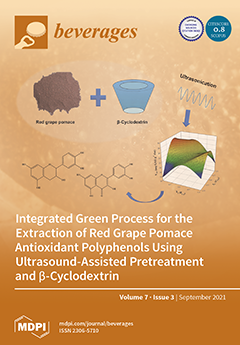The kilning of malt occurs at different temperatures, depending on the desired color and aromas. Higher temperatures applied during kilning can be involved in polycyclic aromatic hydrocarbons (PAHs) formation in malt. PAHs are undesirable and designated as health hazards, it is important to
[...] Read more.
The kilning of malt occurs at different temperatures, depending on the desired color and aromas. Higher temperatures applied during kilning can be involved in polycyclic aromatic hydrocarbons (PAHs) formation in malt. PAHs are undesirable and designated as health hazards, it is important to quantify and qualify them in different malts. Since the European Food Safety Authority (EFSA) gave strict recommendations about PAHs in different foods, but omitted malt as a potential hazardous raw material that can cause health damage to beer consumers, the aim of this investigation was to assess the presence of 16 PAHs (naphthalene (Nap), acenaphthylene (Anl), acenaphthene (Ane), fluorene (Flu), anthracene (Ant), phenanthrene (Phen), fluoranthene (Flt), benz[
a]anthracene (BaA), pyrene (Pyr), chrysene (Chry), benzo[
b]fluoranthene (BbF), benzo[
k]fluoranthene (BkF), benzo[
a]pyrene (BaP), dibenz[
a,h]anthracene (DahA), benzo[
ghi]perylene (BghiP), and indeno[1,2,3-
cd]pyrene (InP)) in different, commercially available malts (amber, black, pilsner, and cara-120). The results showed that PAHs are present in different malts, with some in high amounts (BaA in black malt was 737 µg/kg). Minimal levels of BaA were detected in the amber malt, 60.53 µg/kg. The PAH4 (BaP, BaA, BbF, and Chry) sums are identical to the BaA concentrations in all malts and greatly exceed the EFSA prescribed levels for PAH4 in processed cereal-based foods (1 µg/kg).
Full article





